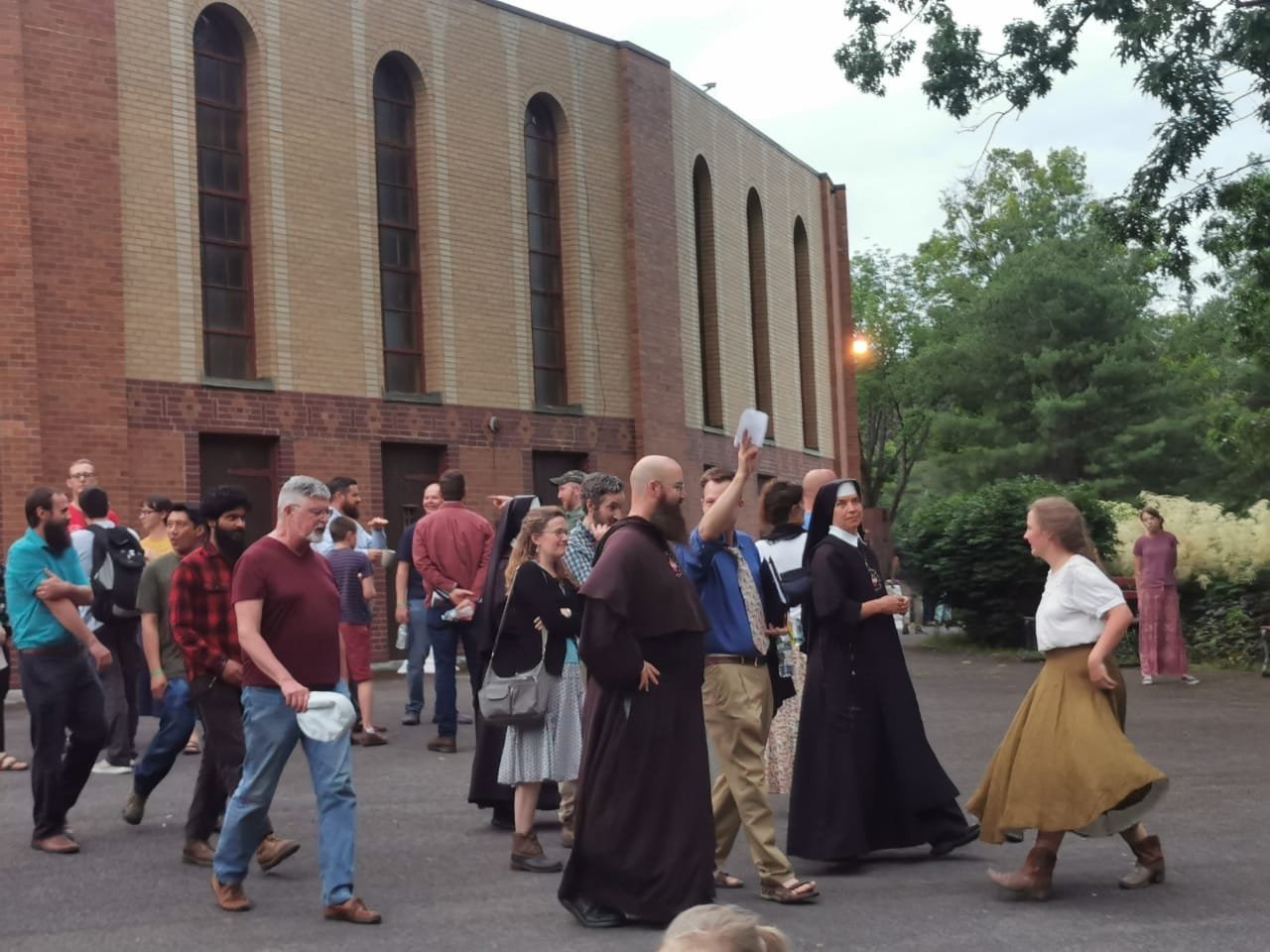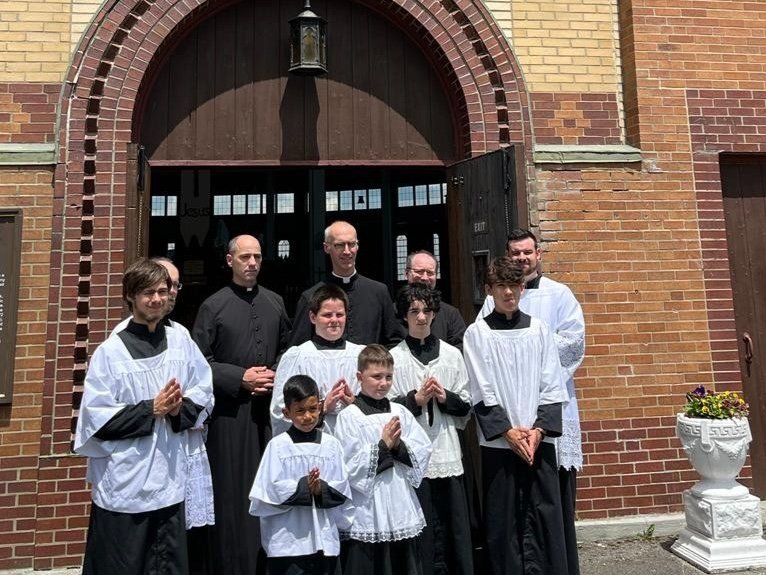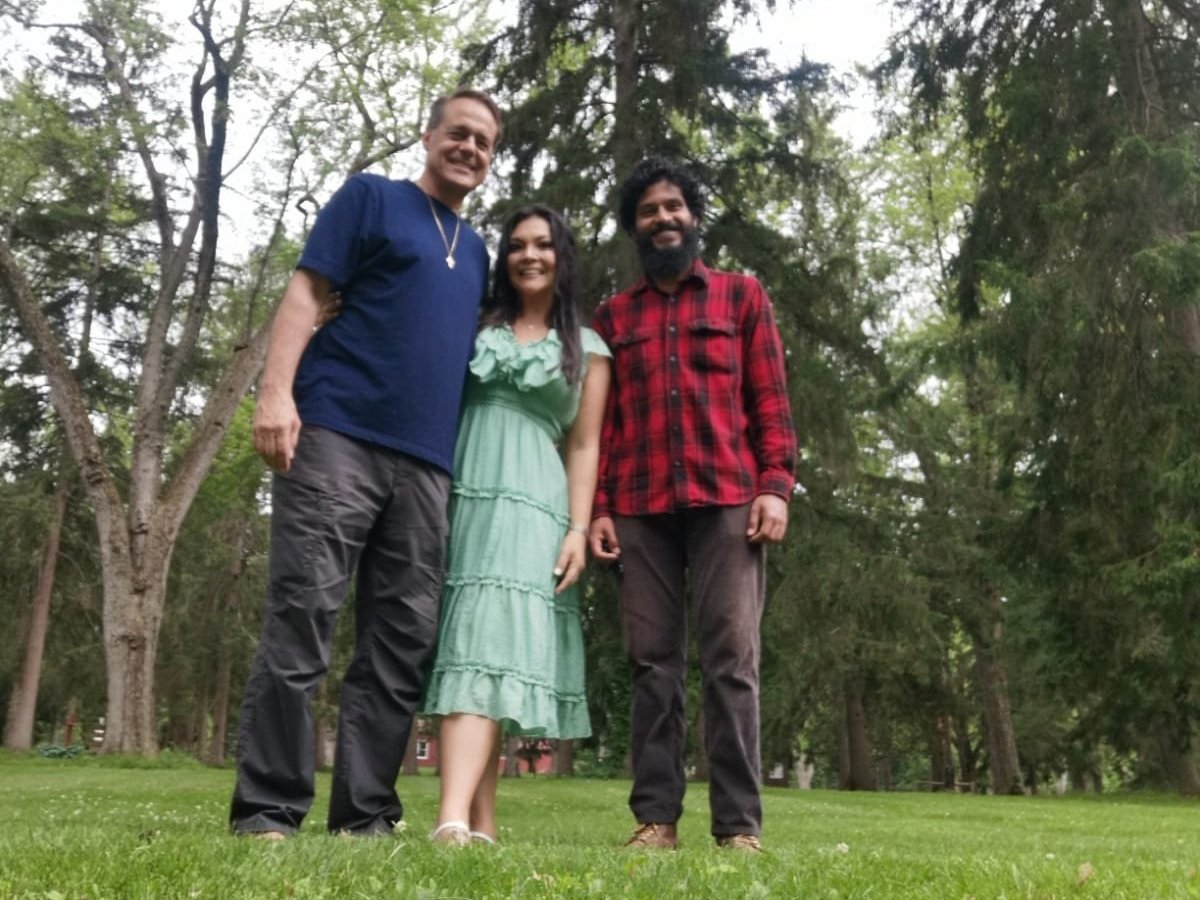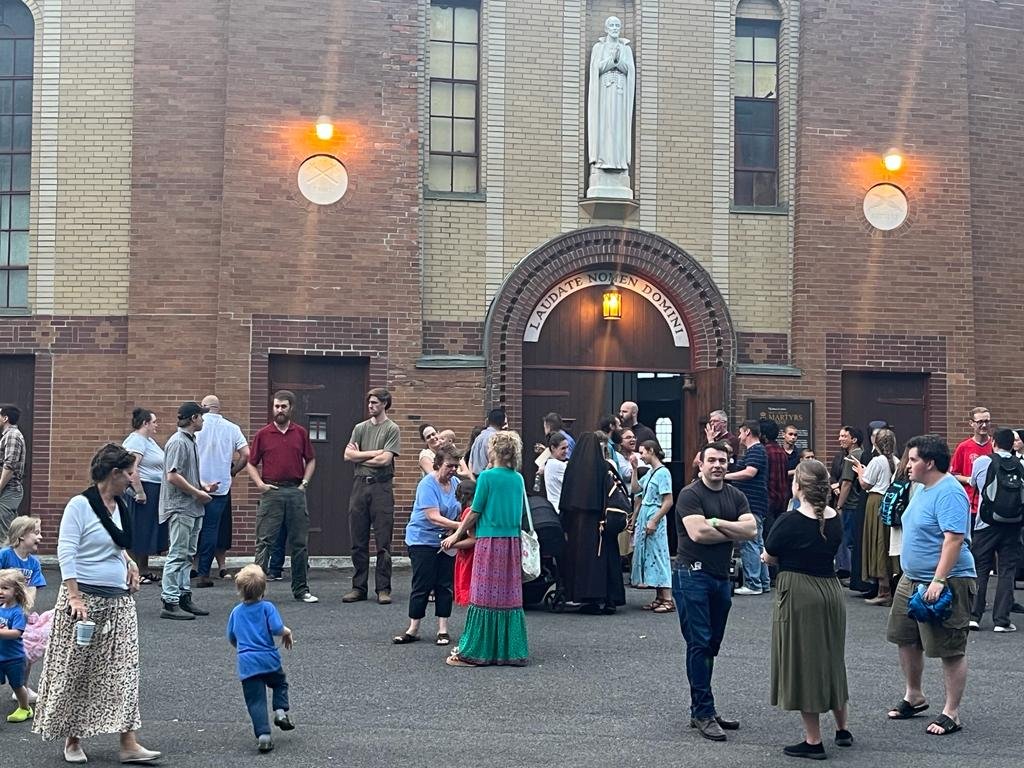Is There a Catholic Back-to-the-Land Movement?
The first Catholic Land Movement sprung up in Great Britain about one hundred years ago. The movement sought to apply Catholic principles to improve the socioeconomic decline of that era. Big businessmen were being favored over peasants, who were pressured to abandon the countryside for wage labor in the city. Large swaths of farmland were thus taken over by big banks throughout the early 20th century. This period of change started the decline of the small family farm and the erosion of traditional family values. Hence the primary objective of the Catholic Land Movement (as printed in its official periodical, The Cross and the Plough) was to restore “Family Subsistence Farming.” The founders set out to teach families practical agrarian skills on “Training Farms,” to place these families on privately owned “subsistence farms,” and to assemble “communities of land workers and craftsmen forming fully rounded village units.”
Notwithstanding the vital energy and rigor of the first Catholic Land Movement, the problems of the previous century have been snowballing to this day. Inventions in industry, transportation, and communication have progressed convenience, comfort, and competition, but regressed our sense of family. Our modern suburban lifestyle promotes individualism and undermines the family unit. In most 21st century households, the entire family is sent away from the home for the majority of the day. In our current social culture, parents and children are so consumed with their own activities that the individuals of the family take precedence over the unity of the family. We have gone from realizing our dependence on God and one another to thinking that we are self-sufficient and independent. But God invites us to live in His goodness on a small family farm (for further reading, explore our Agrarian Lifestyle here on Our Lady’s Ranch website).
Phil, Karen, and Mario meet with Michael Guidice of the Catholic Land Movement
One of God’s most significant plans to reorder the negative trend of our modern culture is the Catholic Land Movement, which is still alive today and experiencing a renewal! The organization held its annual national conference two weeks ago in upstate New York, and we were blessed to be invited. Our Lady’s Ranch is a national community of Catholic homesteaders and a demonstration farm for the Catholic Land Movement, so it was fitting for us to share our resources with the many good folks who attended the conference. We have been homesteading for the last twenty-five years, but while preparing for the conference, we were hard-pressed to define the word “homesteading.” We finally distilled our thoughts into the following description: Homesteading is a wholesome lifestyle that prioritizes the home and the family, while living in a natural way that is connected to the earth. Homesteading should ideally include a small business enterprise to restore the primary income of the family back to the home. But most aspiring homesteaders are not ready for that yet, so we’re encouraging small agrarian activities and hobby-farms as steps toward a family’s future agrarian livelihood.
One of God’s most significant plans to reorder the negative trend of our modern culture is the Catholic Land Movement, which is still alive today and experiencing a renewal!
Michael kicks off the conference with his welcome address
In his welcome address, Michael Guidice, the organizer of the three-day event, focused the attention of the audience on what he called “Primary Things”: food, water, shelter, clothing, and fuel. Humans need these things not only for temporal survival but also to facilitate our eternal salvation, and our gracious God has given us all the means of obtaining these needs from His creation. Michael encouraged us to spend our time at the conference discerning ways in which we may each modify our particular lifestyle in order to obtain one or more of these “Primary Things” more directly from the earth.
The welcome address was followed by a talk from IHS Press chairman John Sharpe, who shared some historical context which predated even our predecessors from the first Catholic Land Movement. According to James J. Walsh, a professor at Fordham University in the early twentieth century, the age of faith ended eight hundred years ago. Thereafter, Catholicism rapidly declined, leading to the Protestant Reformation. Between the Reformation and the Industrial Revolution, there was the rise of classical liberalism. In short, classical liberalism is the ideology that reason supersedes doctrine. This ideology promoted separation between a Catholic’s spiritual life and his secular life. In other words, the Catholic faith was to have no jurisdiction over the political, economic, or social spheres of life. Consequently, the economic system was reconceptualized. It no longer operated in service to the family’s primary needs. Instead, it found its new purpose in the generation and accumulation of individual wealth.
John Sharpe gives a talk on the history behind the Catholic Land Movement
There was a rise in aggressively competitive marketing practices which would not previously have been condoned by the Medieval guilds. “For this is the will of God . . . that no man overreach, nor circumvent his brother in business” (1 Thessalonians 4:3–6). The cardinal sin of greed took root not only among businesses, but between each business and its employees. Laborers no longer owned the property and the tools with which they generated their livelihood, and as a result, there were greater opportunities for the employer to abuse the employee, and for the employee to neglect his duties. “The hireling, and he that is not the shepherd, whose own the sheep are not, seeth the wolf coming, and leaveth the sheep, and flieth” (John 10:12). These problems are inevitable under capitalism and communism. G. K. Chesterton, Hilaire Belloc, and the other founding fathers of the Catholic Land Movement suggest an alternative: Distributism—the principle that each family own and work productive property to generate their livelihood whereby they may prioritize the home and the family.
The founding fathers of the Catholic Land Movement suggest an alternative to capitalism and communism: Distributism—the principle that each family own and work productive property to generate their livelihood whereby they may prioritize the home and the family.
Herein lies the objective of the Catholic Land Movement renewal: to achieve the rise of Catholic distributist homesteads through (1) ideological formation—shedding light on the current moral crisis and the necessity of homesteading as a remedy; (2) practical education—providing training in sustainable agriculture, classical trades, and business management; and (3) social networking—organizing a fellowship of Catholics who can complement each other’s knowledge, skills, and resources. The Catholic Land Movement especially hopes to reunite the laity and the religious in the cooperative cultivation of God’s created land. One such active community already exists near Our Lady of Clear Creek Abbey in Oklahoma. Their Catholic agrarian community lifestyle is not easy, but when God-fearing families are taking to the land with fortitude and faith, there is hope that our society will grow in conformity to what God originally intended.
Ma Brown demonstrates how to spin wool
Two young ladies practice spinning wool just as Ma taught them
At this year’s national conference, several members of the Catholic Land Movement who have plenty of experience as homesteaders, generously volunteered to conduct a wide variety of discussions and workshops. Tim Ehlen, a Catholic scholar and writer, presented on the history of the Catholic Land Movement and overviewed some of the financial options that exist for families who wish to return to a traditional agrarian lifestyle. Brother André Marie, the prior of the Slaves of the Immaculate Heart of Mary in New Hampshire, encouraged the people to embrace farm work as a means of sanctification. Ma Brown, a humble Catholic widow and mother, taught the women and children how to spin wool and seam fabric (traditional skills essential to the role of women who in the ancient Church assisted the clergy by sewing vestments and preparing the Eucharistic host). And there were a number of other workshops on agrarian skills such as beekeeping, herbal medicine, and harvesting chickens and pigs.
Catholic agrarian community lifestyle is not easy, but when God-fearing families are taking to the land with fortitude and faith, there is hope that our society will grow in conformity to what God originally intended.
Phil shares his experience in how to get started with homesteading and community
Philip Zeiter, the founder of Our Lady’s Ranch, led a discussion on how to get started homesteading, and the importance of doing it as a community. He advised each family to seriously consider homesteading with other people. “It’s simply more practical. Why have four milking cows for four families when multiple families can share just one?” And the social interaction is indispensable, especially if you’re a first-time homesteader. Phil also recommended visiting a demonstration farm (like Our Lady’s Ranch) where homesteading aspirants can experience an agrarian lifestyle and learn practical skills. And he encouraged the audience not to put their dreams on hold. “Practice homesteading now in your daily life, wherever you are and however you can. Plant tomatoes in a pot by the window, raise a few laying hens in the backyard, and structure your days around family meals and prayer.”
Jason Craig discusses Catholic manhood and the homestead
Jason Craig, a dairy farmer and writer from North Carolina, shared our appreciation for community. He spoke on the crucial role of the homestead as a place where, unlike the individualistic suburb, people are bound to one another by the land and dependent on each other for their subsistence. Jason also described how boys on a homestead have the opportunity to be initiated into manhood (as opposed to most modern city-dwellers who find themselves trapped in the unnatural phase of adolescence). Jason expresses many of these ideas in his book Leaving Boyhood Behind. He also runs St. Joseph’s Farm, a demonstration farm that hosts retreats for men to grow in maturity through a balance of work, prayer, and rest. Jason is also a founding editor of Sword&Spade, a magazine that carries the torch of The Cross and the Plough from a century ago, and works to bridge the gap between the laborer and the scholar.






In the months to come, the Catholic Land Movement will begin organizing regional chapter conferences. (This year’s Midwest/Appalachia conference has already been announced for mid-September, and more information can be found on the Catholic Land Movement website!) No matter where you live, or what your present means of livelihood, you have the opportunity to become a part of this swiftly growing movement. We invite you to take the next step of joining the conversation by staying in touch with the Catholic Land Movement and Our Lady’s Ranch through the following social media pages.
Our Lady’s Ranch Facebook: https://www.facebook.com/ourladysranch
Our Lady’s Ranch Instagram: https://www.instagram.com/ourladysranch/
Our Lady’s Ranch Twitter: https://twitter.com/ourladysranch
Catholic Land Movement Twitter: https://twitter.com/catholicland
By subscribing to our newsletter below, you won’t miss any further updates. Our next newsletter will expand on the importance of families, relationships, and what it means to belong to a Catholic community.
Blessings & Peace to you,
Mario John Chris
Executive Director
Our Lady’s Ranch—Grass Valley, California
Visit our chat room to meet other like-minded Catholics who are interested in homesteading!









